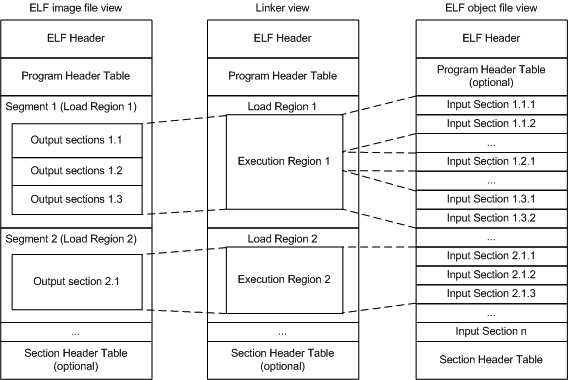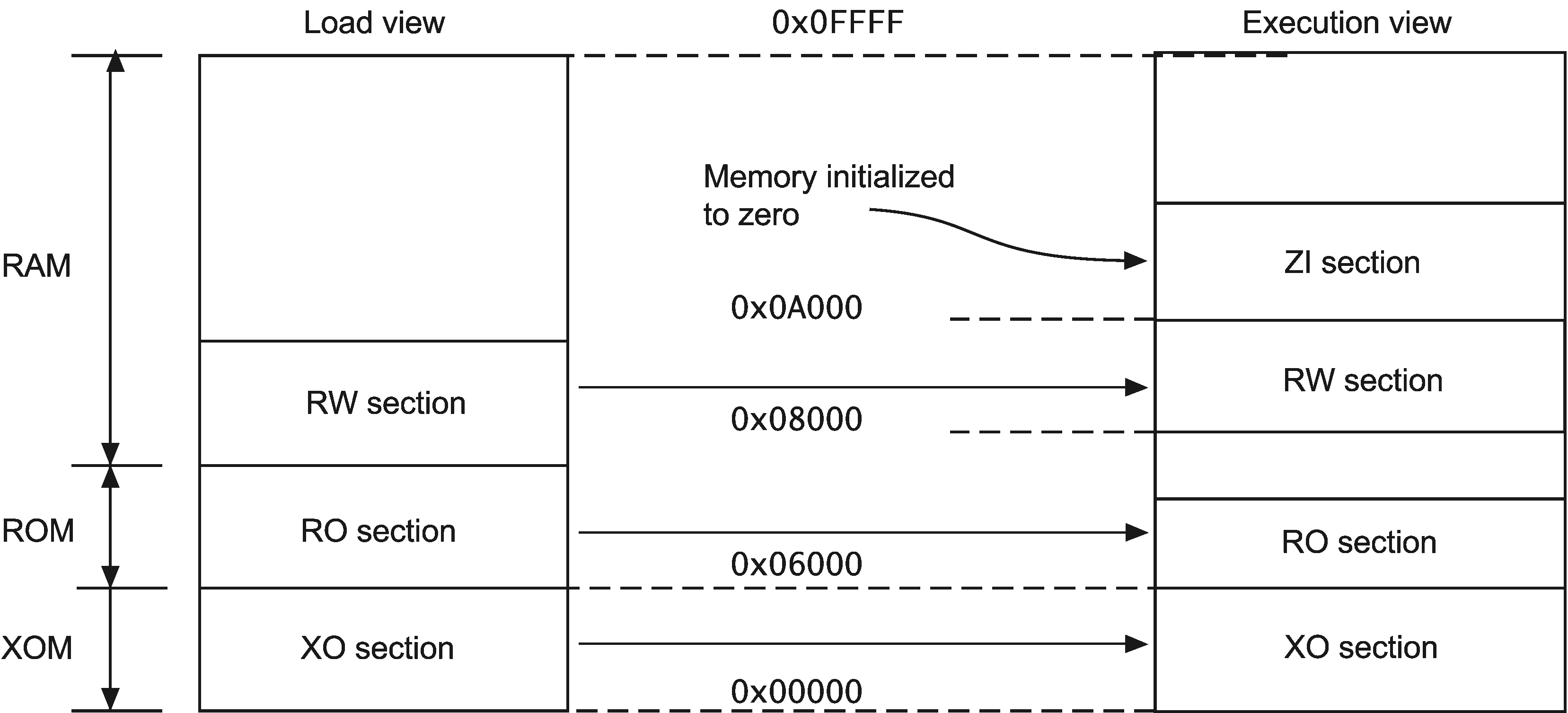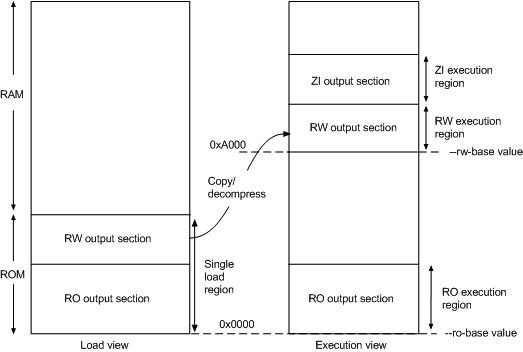3. Image Structure and Generation
名词
Extensible Linking Format(ELF)
3.1 The structure of an ARM ELF image
ARM ELF映像包含sections, regions, and segments,每个链接阶段都有不同的映像视图。
- Number of its constituent regions and output sections.
- Positions in memory of these regions and sections when the image is loaded.
- Positions in memory of these regions and sections when the image executes.
- ELF object file view (linker input)
-
The ELF object file view comprises包含 input sections. The ELF object file can be:
- A relocatable( 浮动的) file that holds code and data suitable for linking with other object files to create an executable or a shared object file.
- A shared object file that holds code and data.
- Linker view
-
The linker has two views for the address space of a program that become distinct in the presence of overlaid(覆盖层的存在), position-independent, and relocatable program fragments (code or data):
- The load address of a program fragment is the target address that the linker expects an external agent such as a program loader, dynamic linker, or debugger to copy the fragment from the ELF file. This might not be the address at which the fragment executes.
- The execution address of a program fragment is the target address where the linker expects the fragment to reside(属于,归于) whenever it participates(参加) in the execution of the program.
If a fragment is position-independent or relocatable, its execution address can vary during execution. - ELF image file view (linker output)
-
The ELF image file view comprises program segments and output sections:
- A load region corresponds to a program segment.
- An execution region contains one or more of the following output sections:
- RO section.
- RW section.
- XO section.
- ZI section.
One or more execution regions make up a load region.
Note
- The term root region means a region that has the same load and execution addresses.
- Load regions are equivalent to ELF segments.

3.2 Input sections, output sections, regions, and program segments
An object or image file is constructed from a hierarchy of input sections, output sections, regions, and program segments.
- Input section
-
An input section is an individual section from an input object file. It contains code, initialized data, or describes a fragment of memory that is not initialized or that must be set to zero before the image can execute. These properties are represented by attributes such as RO, RW, XO, and ZI. These attributes are used by armlink to group input sections into bigger building blocks called output sections and regions.
- Output section
-
An output section is a group of input sections that have the same RO, RW, XO, or ZI attribute, and that are placed contiguously in memory by the linker. An output section has the same attributes as its constituent input sections. Within an output section, the input sections are sorted according to the section placement rules.
- Region
-
A region contains up to four output sections depending on the contents and the number of sections with different attributes. By default, the output sections in a region are sorted according to their attributes. Any XO output section is first, followed by the RO output section, then the RW output section, and finally the ZI output section. A region typically maps onto a physical memory device, such as ROM, RAM, or peripheral. You can change the order of output sections using scatter-loading.
- Program segment
-
A program segment corresponds to a load region and contains execution regions. Program segments hold information such as text and data.
3.3 Load view and execution view of an image
Image regions are placed in the system memory map at load time. The location of the regions in memory might change during execution.
- Load view
-
Describes each image region and section in terms of the address where it is located when the image is loaded into memory, that is, the location before image execution starts.
- Execution view
-
Describes each image region and section in terms of the address where it is located during image execution.


Table 3-1 Comparing load and execution views
| Load | Description | Execution | Description |
|---|---|---|---|
| Load address | The address where a section or region is loaded into memory before the image containing it starts executing. The load address of a section or a non-root region can differ from its execution address | Execution address | The address where a section or region is located while the image containing it is being executed |
| Load region | A load region describes the layout of a contiguous chunk of memory in load address space. | Execution region | An execution region describes the layout of a contiguous chunk of memory in execution address space. |
3.6 Type 1 image structure, one load region and contiguous execution regions
A Type 1 image consists of a single load region in the load view and three execution regions placed contiguously in the memory map.

armlink --ro_base 0x8000
Note
0x8000 is the default address, so you do not have to specify --ro_base for the example.Load view
Execution view
--ro_base address to specify the load and execution address of the region containing the RO output. The default address is 0x8000.--zi_base command-line option to specify the base address of a ZI execution region.Load view for images containing execute-only regions
--ro_base. The RO and RW output sections are placed consecutively and immediately after the XO section.Execution view for images containing execute-only regions
--ro_base. The RO, RW, and ZI execution regions are placed contiguously and immediately after the XO execution region.3.7 Type 2 image structure, one load region and non-contiguous execution regions
A Type 2 image consists of a single load region, and three execution regions in execution view. The RW execution region is not contiguous with the RO execution region.

armlink --ro_base 0x0 --rw_base 0xA000
Load view
Execution view
--ro_base address to specify the load and execution address for the RO output section, and --rw_base address to specify the execution address of the RW output section. If you do not use the --ro_base option to specify the address, the default value of 0x8000 is used by armlink. For an embedded system, 0x0 is typical for the --ro_base value. If you do not use the --rw_base option to specify the address, the default is to place RW directly above RO (as in a Type 1 image).--zi_base command-line option to specify the base address of a ZI execution region.Note
Load view for images containing execute-only regions
--ro_base. The RO and RW output sections are placed consecutively and immediately after the XO section.Execution view for images containing execute-only regions
--ro_base. The RO execution region is placed contiguously and immediately after the XO execution region.--xo_base address, then the XO execution region is placed in a separate load region at the specified address.3.8 Type 3 image structure, multiple load regions and non-contiguous execution regions
A Type 3 image is similar to a Type 2 image except that the single load region is split into multiple root load regions.

armlink --split --ro_base 0x8000 --rw_base 0xE000
Load view
Execution view
--ro_baseaddress-
Instructs armlink to set the load and execution address of the region containing the RO section at a four-byte aligned
address, for example, the address of the first location in ROM. If you do not use the--ro_baseoption to specify the address, the default value of0x8000is used byarmlink. --rw_baseaddress-
Instructs armlink to set the execution address of the region containing the RW output section at a four-byte aligned
address. If this option is used with--split, this specifies both the load and execution addresses of the RW region, for example, a root region. --split-
Splits the default single load region, that contains both the RO and RW output sections, into two root load regions:
- One containing the RO output section.
- One containing the RW output section.
You can then place them separately using--ro_baseand--rw_base.
Load view for images containing XO sections
--ro_base. The RO and RW output sections are placed consecutively and immediately after the XO section.--split, then the one load region contains the XO and RO output sections, and the other contains the RW output section.Execution view for images containing XO sections
--ro_base. The RO execution region is placed contiguously and immediately after the XO execution region.--split, then the XO and RO execution regions are placed in the first load region, and the RW and ZI execution regions are placed in the second load region.--xo_base address, then the XO execution region is placed at the specified address in a separate load region from the RO execution region.3.11 Section placement with the linker
The linker places input sections in a specific order by default.
- By attribute as follows:
- Read-only code.
- Read-only data.
- Read-write code.
- Read-write data.
- Zero-initialized data.
- By input section name if they have the same attributes. Names are considered to be case-sensitive and are compared in alphabetical order using the ASCII collation sequence for characters.
- By a tie-breaker if they have the same attributes and section names. By default, it is the order that armlink processes the section. You can override this with the
FIRSTorLASTexecution region attribute.
Note
--tiebreaker=cmdline option uses a more predictable order based on the order the section appears on the command line.- One execute-only (XO) section if the execution region contains only XO sections.
- One RO section if the execution region contains read-only code or data.
- One RW section if the execution region contains read-write code or data.
- One ZI section if the execution region contains Zero-initialized data.
Note
--sort=algorithm command-line option. The linker might change the algorithm to minimize the amount of veneers generated if no algorithm is chosen.Handling unassigned sections
- If the sections must be placed at specific locations, then modify your scatter file to include specific module selectors and input section selectors as required.
- If the placement of the unassigned sections is not important, you can use one or more
.ANYmodule selectors with optional input section selectors.
Examples
LoadRegion 0x8000
{
ExecRegion1 0x0000 0x4000
{
*(sections)
*(moresections)
}
ExecRegion2 0x4000 0x2000
{
*(evenmoresections)
}
}
3.12 Section placement with the FIRST and LAST attributes
You can make sure that a section is placed either first or last in its execution region. For example, you might want to make sure the section containing the vector table is placed first in the image.
- If you are not using scatter-loading, use the
--firstand--lastlinker command-line options to place input sections. - If you are using scatter-loading, use the attributes
FIRSTandLASTin the scatter file to mark the first and last input sections in an execution region if the placement order is important.However,FIRSTandLASTmust not violate the basic attribute sorting order. For example,FIRST RWis placed after any read-only code or read-only data.
3. Image Structure and Generation的更多相关文章
- GC那些事儿--Android内存优化第一弹
引言 接App优化之内存优化(序), 作为App优化系列中内存优化的一个小部分. 由于内存相关知识比较生涩, 内存优化中使用到的相关工具, 也有很多专有名词. 对Java内存管理, GC, Andro ...
- Android内存优化5 了解java GC 垃圾回收机制3
引言 接App优化之内存优化(序), 作为App优化系列中内存优化的一个小部分. 由于内存相关知识比较生涩, 内存优化中使用到的相关工具, 也有很多专有名词. 对Java内存管理, GC, Andro ...
- Apache Kafka: Next Generation Distributed Messaging System---reference
Introduction Apache Kafka is a distributed publish-subscribe messaging system. It was originally dev ...
- JVM Specification 9th Edition (3) Chapter 2. The Structure of the Java Virtual Machine
Chapter 2. The Structure of the Java Virtual Machine 内容列表 2.1. The class File Format (class文件的格式) 2. ...
- 1.2 the structure of a compiler
Compiler 1.2 the structure of a compiler Compiler : analysis and synthesis syntactically 语法上的 sema ...
- 《The challenge of realistic music generation: modelling raw audio at scale》论文阅读笔记
The challenge of realistic music generation: modelling raw audio at scale 作者:Deep mind三位大神 出处:NIPS ...
- 《SONG FROM PI: A MUSICALLY PLAUSIBLE NETWORK FOR POP MUSIC GENERATION》论文笔记
出处:ICLR 2017 Motivation 提出一个通用的基于RNN的pop music生成模型,在层次结构中封装了先验乐理知识(prior knowledge about how pop mus ...
- 《MIDINET: A CONVOLUTIONAL GENERATIVE ADVERSARIAL NETWORK FOR SYMBOLIC-DOMAIN MUSIC GENERATION》论文阅读笔记
出处 arXiv.org (引用量暂时只有3,too new)2017.7 SourceCode:https://github.com/RichardYang40148/MidiNet Abstrac ...
- 《MuseGAN: Multi-track Sequential Generative Adversarial Networks for Symbolic Music Generation and Accompaniment》论文阅读笔记
出处:2018 AAAI SourceCode:https://github.com/salu133445/musegan abstract: (写得不错 值得借鉴)重点阐述了生成音乐和生成图片,视频 ...
随机推荐
- CSS3 @media 查询(制作响应式布局)
这里简单说明一下@media 查询. 详细说明文档:http://www.runoob.com/cssref/css3-pr-mediaquery.html 使用 @media 查询,你可以针对不同的 ...
- 排序+模拟+优先队列——cf1248E
其实是个模拟题.. /* 每个人都有一个口渴时间,如果口渴时,其前面没有人在排队,那么其就去排队接水,反之一直等到前面没有人排队 问每个人接完水的时间 每个没轮到的人都在位置上等前面的人接完水,然后他 ...
- kubernetes(k8s)Pod污点与容忍
污点(taints)与容忍(tolerations) 对于nodeAffinity无论是硬策略还是软策略方式,都是调度 pod 到预期节点上,而Taints恰好与之相反,如果一个节点标记为 Taint ...
- 12.RabbitMQ多机集群
配置两台Linux CentOS 6.7虚拟主机 CentOS6.7下载地址 https://pan.baidu.com/s/1i5GPg9n 安装视频下载 https://pan.baidu.c ...
- jeecg随笔 -- 实体关联属性的设计
转载:https://www.iteye.com/blog/1868620 在jeecg 里 ,是根据数据库生成实体的,很多关联关系需要自己进行进一步整理才能满足我们的业务需求 例如外键关系 由于很多 ...
- 1.5 React 与 DOM
在这一节中,主要的讨论范围为 React 与 DOM 相关的处理,包括: 如何获取 DOM 元素 如何做事件响应处理 表单处理 style 属性 这节讲述过后,我们将会为 TODO 应用添加完整的事件 ...
- Decision Tree、Random Forest、AdaBoost、GBDT
原文地址:https://www.jianshu.com/p/d8ceeee66a6f Decision Tree 基本思想在于每次分裂节点时选取一个特征使得划分后得到的数据集尽可能纯. 划分标准 信 ...
- AWT Button类
按钮是一个控制组件,按下时有一个标签,并生成一个事件.当按钮被按下和释放,AWT发送ActionEvent的一个实例的按钮,通过调用按钮上的processEvent.按钮的processEvent方法 ...
- Java集成开发环境IDEA
一,安装 1,从http://www.jetbrains.com/idea/download/下载最新的community(free)版本. 2,解压文件 3,进入解压目录下的bin目录 4,执行id ...
- 搭建一个自己的SVN服务器
其实方法非常简单,点点鼠标就好了. 上网搜索“VisualSVN Server”,一般来说都是会找到 https://www.visualsvn.com/server/ 这个网站的. 点击上边的Dow ...
